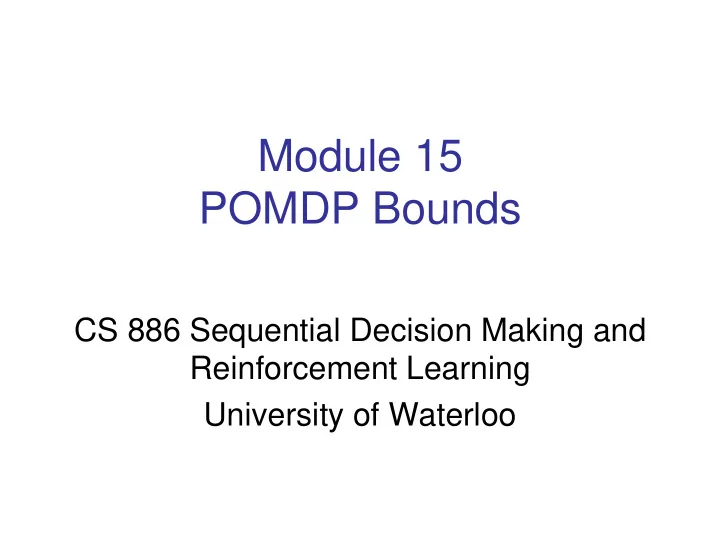

Module 15 POMDP Bounds CS 886 Sequential Decision Making and Reinforcement Learning University of Waterloo
Bounds • POMDP algorithms typically find approximations to optimal value function or optimal policy – Need some performance guarantees • Lower bounds on 𝑊 ∗ – 𝑊 𝜌 for any policy 𝜌 – Point-based value iteration • Upper bounds on 𝑊 ∗ – QMDP – Fast-informed bound – Finite Belief-State MDP 2 CS886 (c) 2013 Pascal Poupart
Lower Bounds • Lower bounds are easy to obtain • For any policy 𝜌 , 𝑊 𝜌 is a lower bound since 𝑊 𝜌 𝑐 ≤ 𝑊 ∗ 𝑐 ∀𝜌, 𝑐 • The main issue is to evaluate a policy 𝜌 3 CS886 (c) 2013 Pascal Poupart
Point-based Value Iteration • Theorem: If 𝑊 0 is a lower bound, then the value functions 𝑊 𝑜 produced by point-based value iteration at each iteration 𝑜 are lower bounds. • Proof by induction – Base case: pick 𝑊 0 to be a lower bound 𝑜 𝑐 ≤ 𝑊 ∗ 𝑐 ∀𝑐 – Inductive assumption: 𝑊 – Induction: • Let Τ 𝑜+1 be the set of 𝛽 -vectors for some set 𝐶 of beliefs ∗ • Let Τ 𝑜+1 be the set of 𝛽 -vectors for all beliefs 𝛽 𝑐 ≤ 𝑊 ∗ (𝑐) • Hence 𝑊 𝑜+1 𝑐 = max 𝛽∈Τ 𝑜+1 𝛽(𝑐) ≤ max ∗ 𝛽∈Τ 𝑜+1 4 CS886 (c) 2013 Pascal Poupart
Upper Bounds • Idea: make decision based on more information than normally available to obtain higher value than optimal. • POMDP: states are hidden • MDP: states are observable • Hence 𝑊 𝑁𝐸𝑄 ≥ 𝑊 𝑄𝑃𝑁𝐸𝑄 5 CS886 (c) 2013 Pascal Poupart
QMDP Algorithm • Derive upper bound from MDP Q-function by allowing the state to be observable • Policy: 𝑡 𝑢 → 𝑏 𝑢 QMDP(POMDP) Solve MDP to find 𝑅 𝑁𝐸𝑄 Pr 𝑡 ′ 𝑡, 𝑏 max 𝑅 𝑁𝐸𝑄 𝑡, 𝑏 = 𝑆 𝑡, 𝑏 + 𝛿 𝑏 ′ 𝑅 𝑁𝐸𝑄 (𝑡′, 𝑏′) 𝑡 ′ 𝑐 = max 𝑐 𝑡 𝑅 𝑁𝐸𝑄 (𝑡, 𝑏) Let 𝑊 𝑡 𝑏 Return 𝑊 6 CS886 (c) 2013 Pascal Poupart
Fast Informed Bound • QMDP upper bound is too loose – Actions depend on current state (too informative) • Tighter upper bound: fast Informed bound (FIB) – Actions depend on previous state (less informative) 𝐺𝐽𝐶 ≥ 𝑊 ∗ 𝑊 𝑁𝐸𝑄 ≥ 𝑊 7 CS886 (c) 2013 Pascal Poupart
FIB Algorithm • Derive upper bound by allowing the previous state to be observable • Policy: 𝑡 𝑢−1 , 𝑏 𝑢−1 , 𝑝 𝑢 → 𝑏 𝑢 FIB(POMDP) Find 𝑅 𝐺𝐽𝐶 by value iteration Pr 𝑡 ′ 𝑡, 𝑏 Pr 𝑝 ′ 𝑡 ′ , 𝑏 𝑅 𝐺𝐽𝐶 (𝑡 ′ , 𝑏 ′ ) 𝑅 𝐺𝐽𝐶 𝑡, 𝑏 = 𝑆 𝑡, 𝑏 + 𝛿 𝑏 ′ max 𝑝 ′ 𝑡 ′ 𝑐 = max 𝑐 𝑡 𝑅 𝐺𝐽𝐶 (𝑡, 𝑏) Let 𝑊 𝑡 𝑏 Return 𝑊 8 CS886 (c) 2013 Pascal Poupart
FIB Analysis 𝐺𝐽𝐶 ≥ 𝑊 ∗ • Theorem: 𝑊 𝑁𝐸𝑄 ≥ 𝑊 • Proof: Pr 𝑡 ′ 𝑡, 𝑏 max 𝑏 ′ 𝑅 𝑡 ′ , 𝑏 ′ 1) 𝑅 𝑁𝐸𝑄 𝑡, 𝑏 = 𝑆 𝑡, 𝑏 + 𝛿 𝑡 ′ Pr 𝑡 ′ 𝑡, 𝑏 Pr 𝑝 ′ 𝑡 ′ , 𝑏 max = 𝑆 𝑡, 𝑏 + 𝛿 𝑏 ′ 𝑅(𝑡 ′ , 𝑏 ′ ) 𝑡 ′ 𝑝 ′ Pr 𝑡 ′ 𝑡, 𝑏 Pr 𝑝 ′ 𝑡 ′ , 𝑏 𝑅(𝑡 ′ , 𝑏 ′ ) ≥ 𝑆 𝑡, 𝑏 + 𝛿 𝑏 ′ max 𝑝 ′ 𝑡 ′ = 𝑅 𝐺𝐽𝐶 (𝑡, 𝑏) 𝐺𝐽𝐶 ≥ 𝑊 ∗ since 𝑊 2) 𝑊 𝐺𝐽𝐶 is based on observing the previous state (too informative) 9 CS886 (c) 2013 Pascal Poupart
Finite Belief-State MDP • Belief state MDP: all beliefs are treated as states 𝑊 ∗ 𝑐 = max 𝑅 ∗ (𝑐, 𝑏) 𝑏 • QMDP and FIB: value of each interior belief is 𝑐 = max 𝑐 𝑡 𝑅 𝐺𝐽𝐶 (𝑡, 𝑏) interpolated: i.e., 𝑊 𝑡 𝑏 • Idea: retain subset of beliefs – Interpolate value of remaining beliefs 10 CS886 (c) 2013 Pascal Poupart
Finite Belief-State MDP • Belief state MDP 𝑅 𝑐, 𝑏 = 𝑆 𝑐, 𝑏 + 𝛿 Pr 𝑝 ′ 𝑐, 𝑏 𝑏 ′ 𝑅(𝑐 𝑏,𝑝 , 𝑏 ′ ) max 𝑝 ′ • Let 𝐶 be a subset of representative beliefs • Approximate 𝑅(𝑐 𝑏,𝑝 , 𝑏 ′ ) with lowest interpolation – Linear program 𝑅 𝑐 𝑏,𝑝 , 𝑏 ′ = min 𝑑 𝑐 𝑅 𝑐, 𝑏 ′ 𝑐∈𝐶 𝑑 such that 𝑑 𝑐 = 1 and 𝑑 𝑐 ≥ 0 ∀𝑐 𝑐 11 CS886 (c) 2013 Pascal Poupart
Finite Belief-State MDP Algorithm • Derive upper bound by interpolating values based on a finite subset of values FiniteBeliefStateMDP(POMDP) Find 𝑅 𝐶 by value iteration Pr 𝑝 ′ 𝑐, 𝑏 max 𝑏 ′ 𝑅 𝐶 (𝑐 𝑏𝑝 ′ , 𝑏 ′ ) 𝑅 𝐶 𝑐, 𝑏 = 𝑆 𝑐, 𝑏 + 𝛿 ∀𝑐 ∈ 𝐶, 𝑏 𝑝 ′ where 𝑅 𝐶 𝑐 𝑏𝑝 ′ , 𝑏 ′ 𝑑 𝑐 𝑅 𝐶 (𝑐, 𝑏 ′ ) = min 𝑐∈𝐶 𝑑 such that 𝑑 𝑐 = 1 and 𝑑 𝑐 ≥ 0 ∀𝑐 ∈ 𝐶 𝑐∈𝐶 𝑐 = max 𝑐 𝑡 𝑅 𝐶 (𝑡, 𝑏) Let 𝑊 𝑡 𝑏 Return 𝑊 12 CS886 (c) 2013 Pascal Poupart
Recommend
More recommend